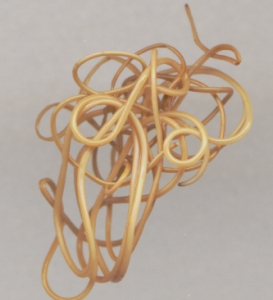Horsehair Worms (cabbagehair, gordiid or gordian worm)
 Scientific Name
Scientific Name
Gordiacea (Nematomorphora)
Habitat
These active, long, thread-like roundworms are occasionally found on sidewalks or patios, in water-troughs and domestic water supplies, on cabbage plants and garden soil, and in the body cavities of various pest insects. Many homeowners wonder whether they are harmful to humans, domestic animals, or plants. Horsehair worms are not harmful to humans, domestic animals, or plants. Adult worms are free-living and non-parasitic. Immature stages are internal parasites of grasshoppers, crickets, cockroaches, beetles, and other insects and millipedes and centipedes.
Identification
Horsehair worms are slender (1/25 to 1/8 inch wide), very long (4 to 24 inches), and yellowish-tan to brownish-black in color. They often squirm and twist, knotting themselves into a loose, ball-like shape, resembling the so called "gordian knot," in freshwater pools. From this resemblance comes the scientific name of the group (Gordiacea). These worms may be found in masses of 100 or more, especially after rainfall. In water troughs and puddles, they resemble horsehairs actively moving in the water. Some people still believe that these worms develop from the long, thin hairs of a horse's mane or tail that fall into the water as a horse drinks.
Life Cycle
The adult worms mate in fresh water or damp soil. The female lays up to several million eggs in water in long strings or slender broken cords. Eggs hatch in two weeks to three months, with the .01 inch larvae not resembling the adults. Some believe that within 24 hours after hatching, the larvae encyst on vegetation near the water's edge. After the water level drops, the exposed vegetation is eaten by a grasshopper or cricket. The cyst covering dissolves, permitting juvenile worms to bore through the gut wall and into the body cavity of the host. All nutrients are absorbed across the body wall of the worm, as no alimentary system is present.
As larvae develop fully or nearly so (several weeks or months), they break through the body wall of the host (in moist habitats) and become free-living. Other people believe that young worm larvae bore into or are swallowed by immature stages of water-inhabiting insects such as mayflies, dragon flies, or beetles. When the host emerges from the water as a free-flying adult, the mature horsehair worm breaks out of the body cavity. Grasshoppers, crickets, etc. may be a second host if they eat the dead, infested mayfly adults. It appears that the host must first come in contact with water to enable horsehair worms to escape the body cavity.
Horsehair worms are most commonly seen following rains in November and early December in Oklahoma. They have also been collected in the late winter and early spring (mid-January to March).
These worms are sometimes seen after crushing pests that have invaded the house. When crushed, worms are released and crawl indoors. Some are found in toilets where infested pests (e.g. crickets) have been discarded, in pet dishes where an infested insect has crawled, or in gardens on vegetable plants. Humans sometimes fear worms may have come from a household pet or children when found indoors.
Control
No control measures are recommended because horsehairworms do not injure humans, domestic animals, or plants. Instead, they are considered beneficial because they kill many harmful pests such as grasshoppers, crickets, cockroaches, beetles, millipedes, and centipedes.
Control of horsehair worms in natural water is impractical. However, one can install a fine mesh filter or screen to keep out tangled masses of worms from a surface supply such as a farm pond or lake. Should the homeowner find nuisance worms in the wash water, bathtub, and sinks, domestic water supply systems can be filtered and chemically treated under supervision of the local health department. Remove and discard individual worms. Prevent nuisance insects from entering the house by caulking or sealing entry sites. An insecticide barrier around the house foundation might be helpful. Livestock water troughs can be kept free of horsehair worms by routine flushing.

